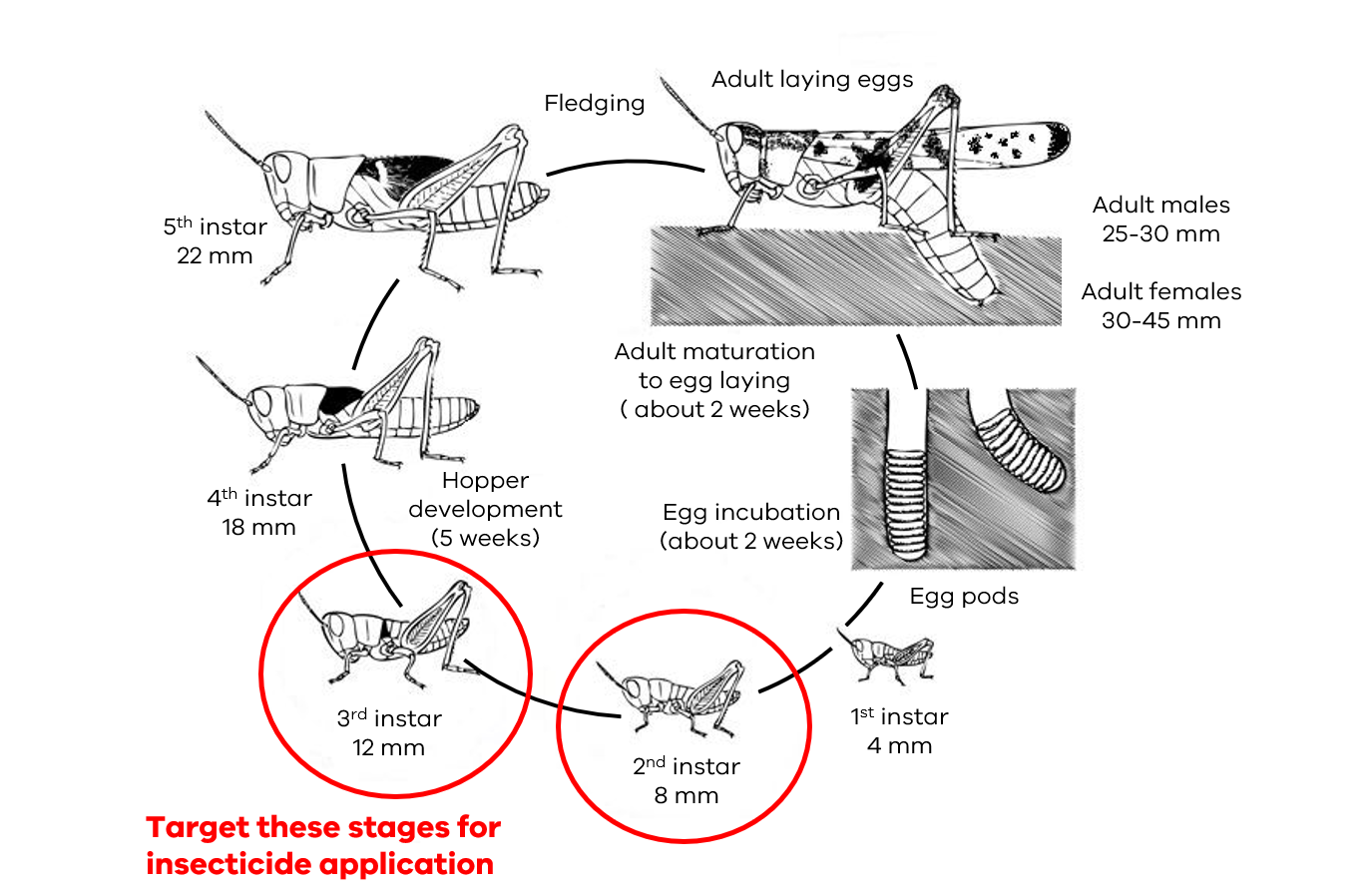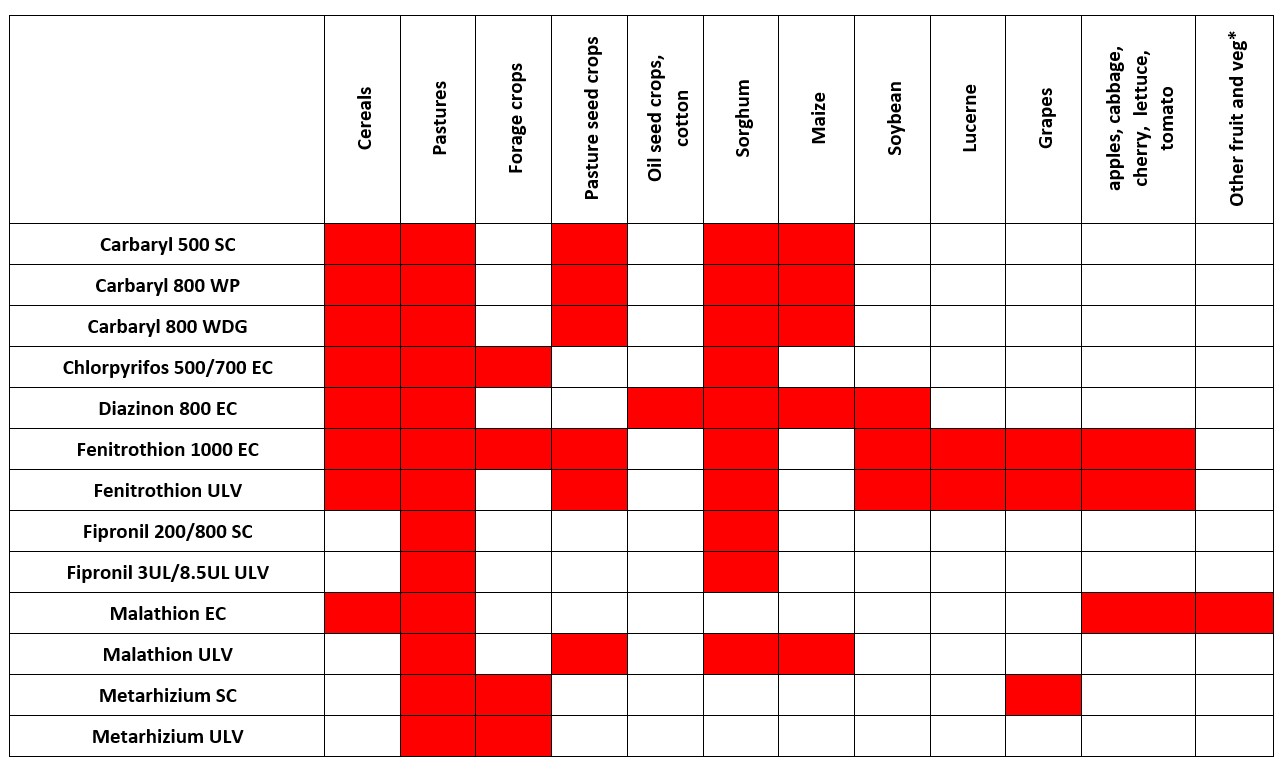Chemical use and crop residues
Managing Australian Plague Locusts
Populations of the Australian Plague Locust (APL) occur episodically in Victoria. They most often migrate into Victoria from their home breeding ranges in New South Wales and Queensland but can also breed further generations within Victoria. In heavy outbreak years they can cause severe economic damage to agricultural and horticultural crops and the amenity of our rural areas.
Control of APL can be difficult, particularly at the adult stage when they are highly mobile and moving in swarms. Eggs which are laid in the soil cannot be effectively controlled. Egg beds may be difficult to spot and could range over large areas. When they hatch, damaging populations can arise in a very short time.
The most effective means of managing APL is to spray the non-flying second and third nymphal stages, when the hoppers have started to band together. This occurs around two weeks after hatching in warm weather.

Widespread aerial spraying is usually deployed for large open spaces and managed by the Australian Plague Locust Commission (APLC) in collaboration with state government authorities. However, in densely populated mixed crop and forested areas, this is the least preferred option.
Control authorities use licenced ground operators to mix and apply control chemicals. Landholders must apply the same level of professional care.
Producers of crops harvested for human consumption, and products derived from animals for human food (meat, eggs, milk), should obtain information about the chemicals which may be applied to control locusts, regardless of whether they are controlling the locusts themselves or control is being undertaken by an outside authority.
Chemicals used for locust control
Chemicals registered for the control of locusts contain different active ingredients and are marketed under a range of brand names. It is important for landholders and contractors to read the product label and ensure the chemical is appropriate to use in their specific situation. The correct choice of insecticide group, and specific product within that group, can only be made after careful consideration of the specific circumstances involved.
The chemicals used for controlling locusts fall into 4 Mode of Action Groups. Users can identify the Group by looking at the front of a chemical label just under the trade name of the product. The Australian Pesticides and Veterinary Medicines Authority has useful information on understanding pesticide labels.
Carbamate (Group 1A) Organophosphate (Group 1B) insecticides
Active ingredients in these groups include carbaryl, chlorpyrifos, diazinon, fenitrothion, maldison (malathion). The pesticides differ chemically but act in a similar manner. A major benefit from using chemicals from these groups is that they break down relatively quickly.
Fenitrothion is commonly used by the APLC for locust control and is registered for use against locusts on pasture and a wide range of cereal and other crops including grazing sorghum, lucerne, apples, grapes, lettuce, tomatoes and soybean.
Fenitrothion is degraded rapidly. On vegetation the level of any residue is halved every day. However, re-entry into treated areas during the 48 hours immediately following application should be restricted. Anyone re-entering treated areas during this period to assess efficacy must take precautions and wear suitable protective clothing. However, it is moderately toxic to mammals and highly toxic to aquatic invertebrates (e.g. shrimps, insects & yabbies) and honeybees.
Phenylpyrazoles (Group 2B)
Phenylpyrazoles are a group of broad-spectrum insecticides, originally developed to manage problematic insecticide resistance. In terms of locust control, Fipronil is the most commonly used member of this group.
Fipronil acts on the insect nervous system and kills by contact or ingestion. It is highly active again locusts which means very low doses can be used. Fipronil is moderately toxic to mammals although the low doses of fipronil needed minimise the risk to terrestrial vertebrates. Fipronil is highly toxic to bees, termites and aquatic invertebrates and should not be applied near waterways.
Synthetic pyrethroid insecticides (Group 3A)
Synthetic pyrethroids are synthetic versions of naturally occurring pyrethrins and have been developed to target specific pest species. They are generally not persistent in the environment and pose a much-reduced risk to mammals while remaining toxic to insects. Some examples include cypermethrin, alpha-cypermethrin, beta-cyfluthrin, lambda-cyhalothrin and gamma-cyhalothrin.
Biologicals
Green Guard® is a registered product name for a biological insecticide which contains the naturally occurring Australian fungus MetaFrhizium anisopliae. The product is relatively specific to locusts and grasshoppers. However, there is a potential hazard to honeybees as they may collect high numbers of spores while foraging on flowering plants.
Locusts and grasshoppers are affected when the Metarhizium spores attach to the insect. The spores germinate and penetrate the surface of the locust, growing into the body and internal organs. Death can occur between 8-21 days; faster in summer but usually taking longer when temperatures are cool. The delay in death means it is advisable to treat when locusts and grasshoppers are in the early nymphal stages and less mobile than the winged adults. Green Guard® most effective when used as a preventative spray, targeting nymphs.
Green Guard® is available in three formulations:
- A suspension concentrate premixed with a carrier then diluted in water;
- A suspension concentrate designed for ground-based application which users are required to mix with emulsifiable oil, fungal spores and surfactant solution before diluting in water; and
- Ultra-low volume formulation designed to be applied aerially in a mix with petroleum oil although it can be applied by mister.
Registrations and permits
Australian law requires all agricultural and veterinary chemical products sold in Australia to be registered by the Australian Pesticides and Veterinary Medicines Authority (APVMA).
Once a product is registered, it is approved for the purposes and the uses stated on the product label. Withholding periods and statements regarding Protection of crops, native and other Non-Target Plants; Protection of Honeybees and other Insect Pollinators; Protection of Wildlife, Fish, Crustaceans and Environment and Spray Drift Restraints much be strictly adhered to.
For more information on how to read and understand product, see: ttps://apvma.gov.au/sites/default/files/publication/67431-understanding_labels_booklet_2020.pdf
To access copies of labels of products registered to control Australian Locust, see: https://portal.apvma.gov.au/pubcris
Off-label use
Off-label use refers to situations when a registered chemical is used in a way that is not listed on the product label. This may be using a chemical on a pest or crop that is not listed on the label.
In Victoria, off-label use is allowed in limited circumstances. Users must assess and address risks of off-label use in terms of efficacy, human health, residues in produce or the environment.
For more information visit Agriculture Victoria's website on Off-label use.
Chemical residues
Chemical residues are traces of a chemical, or its breakdown products, that remain in or on treated produce after a particular time. Chemical residues can occur directly from treating produce and indirectly from exposure of the produce to spray drift or persistent chemicals in the soil.
Maximum residue limits
The maximum residue limit (MRL) is the maximum concentration of a chemical residue that is legally permitted to be present in a food, agricultural commodity or animal feed. This concentration is expressed in milligrams per kilogram of the food.
Crops or produce with residue concentrations below the MRL are considered acceptable for sale or consumption. There may be a greater likelihood that produce treated off-label will contain unacceptable residues, particularly as any residue effects of may be unknown. Note also that residue standards differ between countries and any requirements must be complied with when supplying an export market.
For more information visit Agriculture Victoria's website on chemical residues and MRLs.
Withholding Periods (WHPs)
A withholding period is the minimum length of time that must elapse between the last application of an agricultural chemical to a crop and the harvest, sale or use of the agricultural produce to which the chemical was applied. This is often referred to as the Harvest WHP to distinguish it from a Grazing WHP.
The Grazing WHP is the time that must elapse between the application of the chemical and the livestock grazing or coming into contact with the treated plants. If the Grazing WHP has not expired, the livestock and the produce derived from them (milk, eggs) cannot be sold unless the buyer is notified.
Risks to pollinators
Pollinators like bees are critical to crop production and can be severely affected by inappropriate application of locust control products. Users must read and comply with any label instructions regarding protecting pollinators. These instructions are commonly found in the ‘Protection of Livestock’ section of the label.
Users should also ensure their neighbours are aware of their upcoming spraying in case they have hives temporarily on their property, and users should also do a quick reconnaissance around the target area to see if they can spot any hives, particularly any that may be present on crown land.
Your responsibilities
- Know when spraying is occurring in your area.
- Check what chemicals are being used and observe harvest and grazing withholding periods set out in the product label or on an APVMA permit.
- Comply with all 'DO NOT' statements contain on chemical labels
- Undertake a risk assessment to determine which chemicals are best suited for use on your land.
- Read and follow label instructions and/or permit conditions.
- Understand the record keeping requirements of using agricultural chemicals including keeping records of spray activities.
- Confirm that all relevant WHP have been met before selling produce.
- Consult with neighbours when spraying near property boundaries.
- Consult with apiarists before spraying to give them the opportunity to move their hives.
- Ensure you manage the risk of spray drift, including complying with any instructions included in ‘Spray Drift Restraints’ section of the label.
- If unsure seek further advice from chemical manufacturers, agricultural suppliers and Agriculture Victoria.
Chemical actives and formulations registered for use for Australian plague locusts in Victoria.
